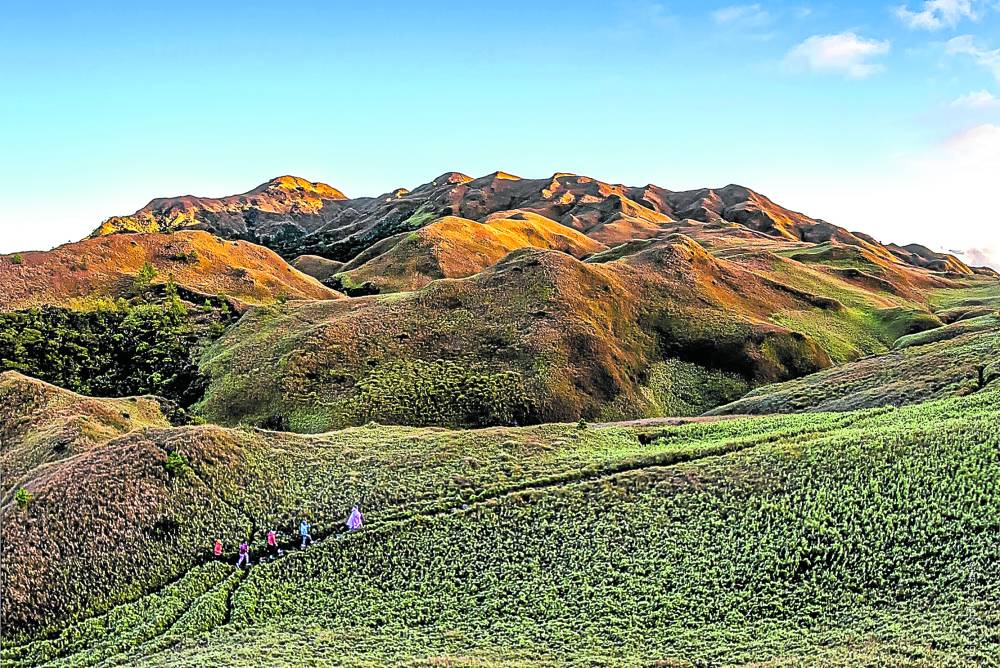
ABOUT TIME Mt. Pulag, Luzon’s highest peak, enters the list of the country’s protected areas under new laws signed by President Duterte on April 8 and announced by the Palace on Thursday. —NOLI GABILO/CONTRIBUTOR
MANILA, Philippines — President Duterte has signed separate laws designating as protected areas Mount Pulag (Luzon’s highest peak), Mount Arayat in Pampanga, the historic Tirad Pass in Ilocos Sur, and other sites in two other provinces.
The designations were made official through Republic Act Nos. 11684, 11685, 11686, 11687 and 11688, which the President signed on April 8.
Declared protected areas are the expanse of Mt. Pulag covering the towns of Kabayan, Bokod and Buguias in Benguet, Tinoc in Ifugao, and Kayapa in Nueva Vizcaya; Mt. Arayat in Arayat and Magalang towns in Pampanga; Banao covering the Balbalasang-Balbalan National Park in Kalinga; Tirad Pass covering the Tirad Pass National Park in Gregorio del Pilar, Quirino, Sigay, Cervantes and Suyo towns in Ilocos Sur, and Naga-Kabasalan covering the Tipan and Busyawan Watersheds in Zamboanga Sibugay.
According to the newly enacted laws, these areas are given such status in recognition of their rich biological resources, both flora and fauna, that are native and distinct to these locations, as well as their aesthetic and ecological importance, which the state must safeguard, manage or rehabilitate.
A protected area refers to portions of land and water set aside for their unique biodiversity and shielded from destructive human exploitation. Examples are natural parks, wildlife sanctuaries, marine reserves, and watershed or mangrove swamp forests.
They are treasured for their crucial role in mitigating the effects of climate change and building resilience to calamities such as typhoons.
Legal basis
In 1992, the government enacted Republic Act No. 7586, or the National Integrated Protected Areas System (Nipas) Act, which called for the management of protected areas, forming them into an integrated system and ensuring their sustainable use while maintaining their natural conditions for future generations.
The law was amended in 2018 by RA 11038, or the Expanded Nipas (Enipas) Act, to enlarge its scope and further strengthen the management system.
Prior to the amended law, the Department of Environment and Natural Resources (DENR) listed only 13 protected areas that were proclaimed through legislation. With the Enipas Act, the list has grown to 244 areas covering a total of 7.76 million hectares as of 2020. Of the 244 sites, 58 are further classified as protected landscapes and seascapes.
By category, watershed forest reserves are the most common (at 20.1 percent), followed by protected landscapes (14.3 percent) and national parks (13.5 percent).
Per region
DENR records show that Region 5 has the most number of protected areas with 26, followed by Region 3 with 24 and Region 4B with 23. In terms of land area, Region 4B has the biggest protected area at 2.34 million ha, followed by Region 2 with 999,320 ha and Region 7 with 637,892 ha.
The Philippine Rise Marine Resource Reserve is notable for being the sole transboundary protected area, spanning across Regions 2, 3, 4B and 5.
The Biodiversity Management Bureau of the DENR provides the overall supervision of all protected areas in the country.
Under the law, each protected area must have a Protected Area Management Board (PAMB) headed by the DENR’s regional, provincial, city or municipal officers. It also includes governors, city and municipal mayors, other officials of national government agencies as well as from nongovernmental organizations.
Income generation
Each protected area must also have its own Protected Area Management Office, headed by a superintendent, to implement policies issued by the PAMBs, and manage, operate, issue the corresponding permits and clearances, and collect fees for allowed activities such as permitted sale and export of flora and fauna, and lease of multiple-use sites.
The protected areas retain 75 percent of the income generated from all allowed activities, and the other 25 percent is being remitted to the national treasury to fund other Nipas programs and projects.
The law likewise requires the Department of Justice to appoint special prosecutors for violators of the laws, rules and regulations in the protected areas. —With a report from Inquirer Research
RELATED STORY:
DENR vows to protect Cordillera’s 616 million trees

